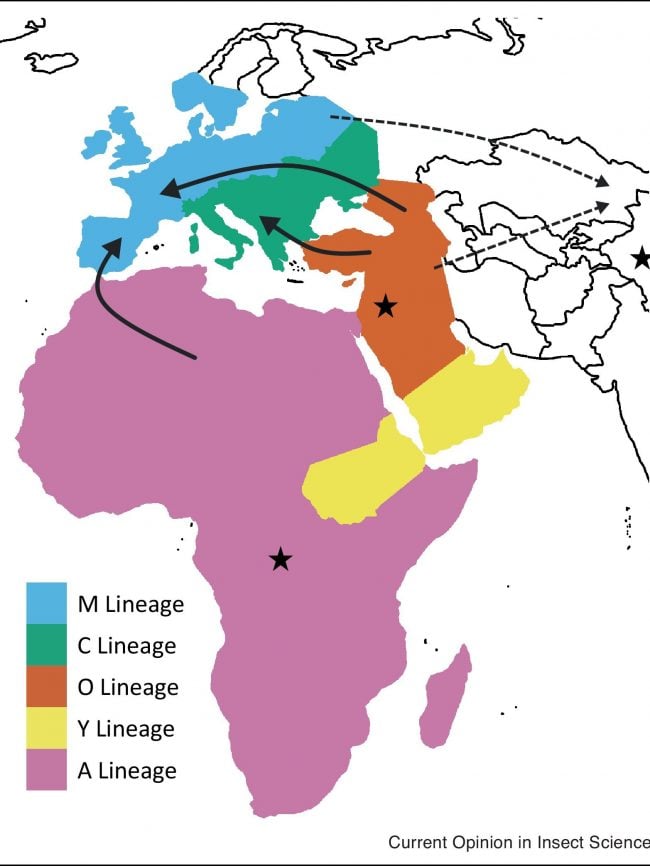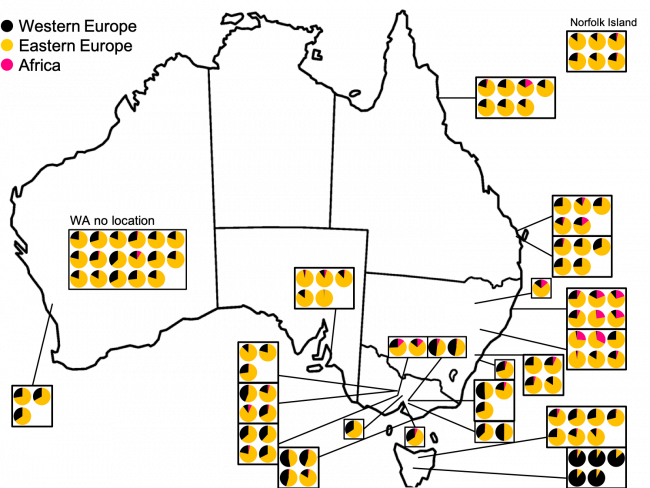The English black bee (Apis mellifera mellifera) was first introduced to Australia in 1822. Lugurian (A. m. ligustica) bees arrived in the early 1860s, Caucasian (A. m. caucasica) in the 1880s and Carniolan (A. m. carnica) in the 1890s. Lesser known imports were made of A. m. iberiensis, A. m. intermissa, A. m. lamarckii, A. m. cypria, A. m. syriaca. It is possible that other subspecies were also introduced; genetic studies have identified A. m. macedonica, although there is no historical report of their introduction.
Honey bees have been divided into at least 5 ancient lineages, as discussed in a previous article. An AgriFutures Australia study created a genetic test to determine honey bee ancestry to 3 of these ancient lineages; Western European (A. m. mellifera, A. m. iberiensis), Eastern European (e.g. A. m. ligustica, A. m. carnica) and African (e.g. A. m. scutellata, A. m. capensis). Note that although Carniolan bees are popular in Australia, the lineage that this subspecies belongs to was not included in the test.

Distribution of honey bee subspecies
Wikimedia Commons

Distribution of the 5 ancestral lineages
Source: K. A Dogantzis & A. Zayed
The test was used on both the managed and feral Australian honey bee populations. All of the examined bees were hybrids of varying degrees. The average commercial bee was 70% Eastern European and 27% Western European. The average feral bee was 57% Eastern European and 39% Western European. This difference between the genetics of commercial and feral bees was expected. The English black bee spread across Australia after its introduction and is concentrated in the feral population, while beekeepers generally prefer to work with lines from the Eastern European lineage.

Ancestry of commercial Australian bees to 3 ancient lineages. Each pie chart represents a single worker.

Ancestry of feral Australian bees to 3 ancient lineages. The samples outlined in blue are from drones collected at drone congregation areas.
Some bees had a fairly large amount of African ancestry. This may be from the small number of imports from northern Africa, where there has been ancient hybridization with bees from Spain and Portugal. Alternatively, it may arise from the test not including the lineage that Caucasian bees belong to. Similar levels of African ancestry were found in commercial populations from the United States and Canada.
Of particular note are the bees from the Tasmanian highlands, which had a very high proportion of Western European ancestry. It is well known that only black bees tend to be able to survive there.
Video
In this presentation, Nadine Chapman discusses the genetic background of Australian honey bees
Should we care that our bees are hybrids?
I think not. As long as we are selecting for the best bees for our conditions and commercial requirements then we are setting ourselves up for success.
Acknowledgements:
- C. Chapman, B. A. Harpur, J. Lim, T. E. Rinderer, M. H. Allsopp, A. Zayed, B. P. Oldroyd (2016) Hybrid origins of Australian honeybees (Apis mellifera). Apidologie 47: 26-34
- This article was written by Nadine Chapman and peer-reviewed by Corinne Jordan and Michael Holmes.

